#Verminaard
Photo
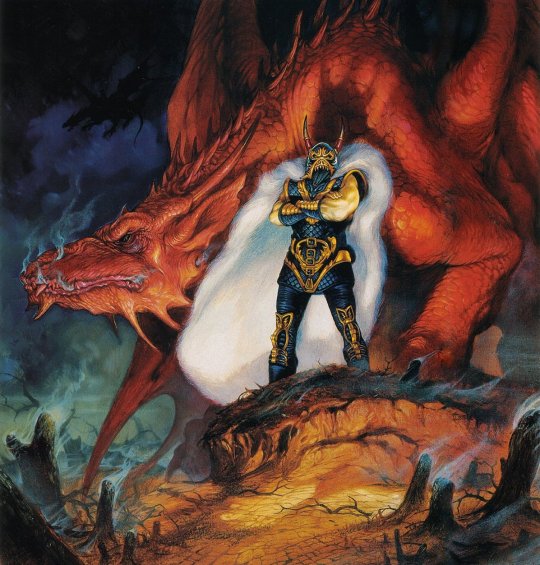
Artist: Jeff Easley
#jeff easley#verminaard#dragonlance#fantasy#sword and sorcery#dnd#dungeons and dragons#dragon#warrior#monster
67 notes
·
View notes
Text
307. Douglas Niles - DL2: Dragons of Flame (1984)

The second module in the Dragonlance series, featuring some fantastic art by Jeff Easley, follows our heroes as they return from Xak Tsaroth in possession of the disks of Mishakal and the restoration of clerical powers to the world, starting with Goldmoon.

If you are not familiar with the modules, but are familiar with the very successful novels, this module basically covers the second half of Dragons of Autumn Twilight, up until the escape from Pax Tharkas and the defeat of Lord Verminaard.
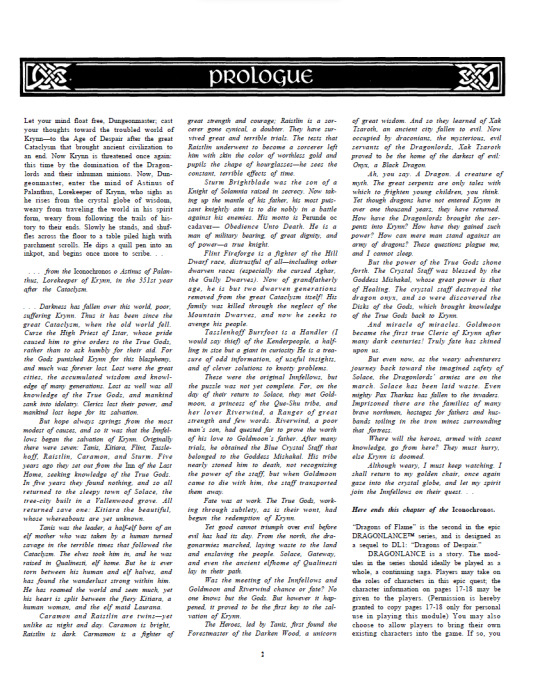
As someone who knows the novels very well, having read them multiple times, it's fun to read here what was already established in the modules and what are innovations for the novels, and there is plenty that is different, although the broad strokes are similar. The novels are basically these modules played through which adds the randomness of the actions of the players to it, the world events are the same however. So it's hard not to see it as a bit of a railroady adventure, although there is plenty of space for player initiative which will change how this is played through, although the finale is pretty much fixed, which might make choice feel a bit illusory. Still, a truly classic adventure, with great art and maps.

14 notes
·
View notes
Text
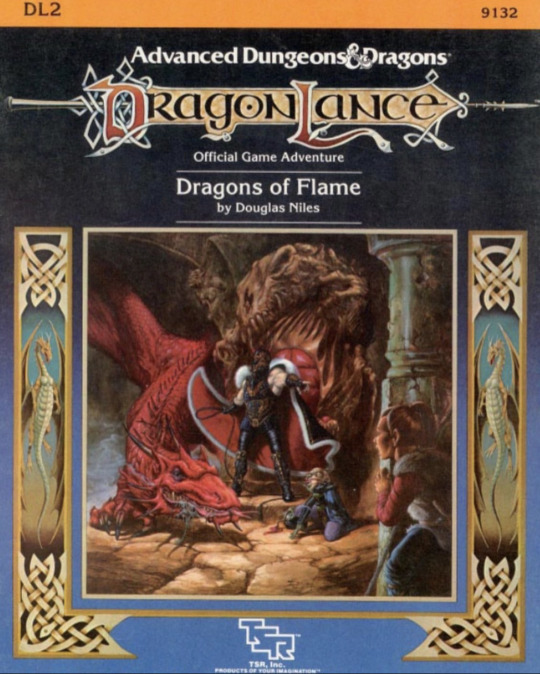
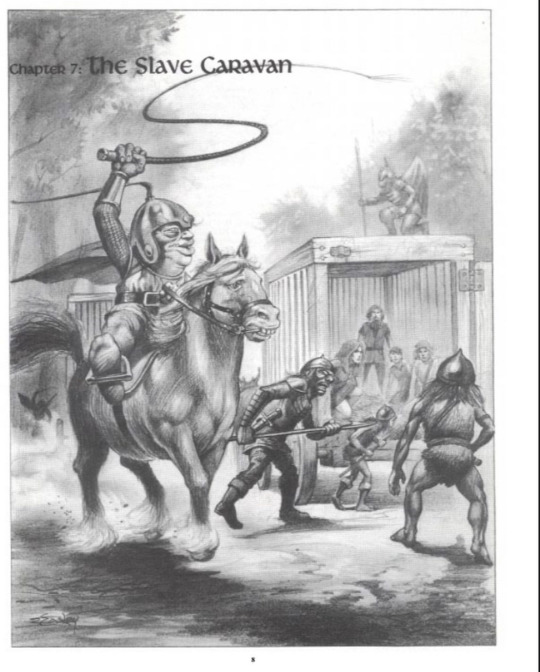




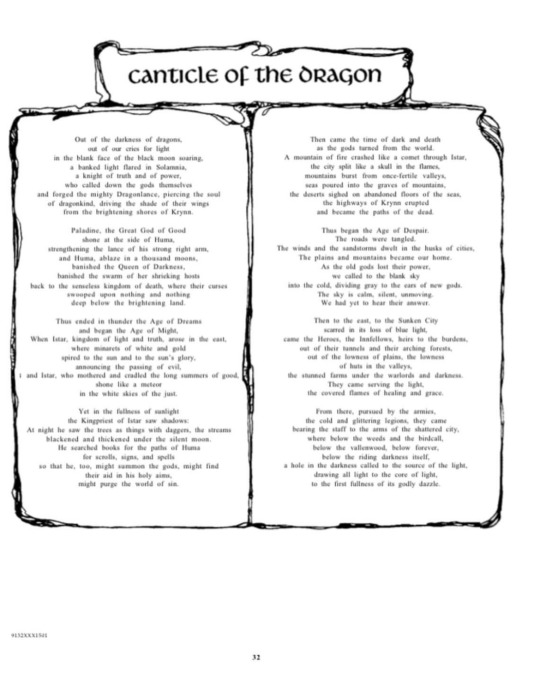

DL2, Dragons of Flame from the TSR 1984. Dragons of Flame is the second module in the first major story arc in the Dungeons & Dragons Dragonlance series of game modules. Its cover features a painting by Jeff Easley depicting Tasslehoff Burrfoot peering at a red dragon and Verminaard of the Dragonarmies of Ansalon. Continuing from the previous module, Dragons of Despair, players reenact the Dragonlance story using the pre-generated players. The player characters return to their hometown and find it overrun by evil; the elves of Qualinost hire them to free captives that the Draconians have imprisoned in the fortress of Pax Tharkas.
The same player characters from Dragons of Despair are available again, with their character sheets reflecting that they have each increased a level from the previous adventure. Tika becomes a playable character at the end of chapter six, and Gilthanas, a new character, becomes playable at the end of chapter eight. Laurana, who becomes a playable character in DL6 Dragons of Ice, also makes her debut in this module. While I wasn’t really a fan of pre-generated characters, and there was no XP incentive, and it was a bit of a railroad, it was still fun playing it the events in the books.
20 notes
·
View notes
Text
Started writing a TTRPG campaign for friends
I decided to share this here because I'm kind of happy where it's going so far. Have a sneak peek!
--
The Cataclysm left the continent of Ansalon in ruins. Seas rushed in where none had been before, cities formerly on a coastline were landlocked, their economies in ruins. Worst of all, the gods of the world had abandoned them, leaving the faithful scattered and torn. Now, 300 years later, rumors are beginning to spread that the gods have returned. Some say that the gods mean nothing, that they abandoned the world when the Cataclysm fell, so why should they believe in them? Some say the gods never left and simply waited for the world to find their way back to their embrace. Regardless of what did or did not happen to the gods, the clouds of war are gathering over Ansalon.
You are an adventurer on a mission. Whether you search for the gods, treasure, family, or some motive yet unknown, your goal is the same: Stop the advance of the Dark Queen’s forces and prevent war from spreading across all of Krynn. You and your companions will face many challenges, fighting the dragon armies on your journey. You may even come face to face with a god or two.
One thing is certain: Takisis, the Queen of Darkness, must not win.
—
You begin your adventure in a town called Solace, on the Plains of Abanasinia. The town is in rough shape after the Red Dragon Army, led by the ruthless Dragon Highlord Verminaard, laid waste to all those who opposed him. Any who stood against him were taken prisoner and transported by goblins and draconians south past Qualinesti and into the mountains separating Abanisina from the Plains of Dust. There lay a mine, where the men were separated from their families and forced to labor away, while the women were forced to cook for the dragon army. The children, meanwhile, were placed under the care of an old, blind red dragon who had a soft spot for young ones after her own children were taken from her and murdered in a war that occurred many centuries ago. She cared not for the men in charge, but would defend her children with her life.
You find yourself in the burned out town, doing your best to avoid the attention of the occupiers lest you get dragged into the mines yourself. The Inn of the Last Home, once found atop the tallest tree in the region, had been ripped up from its foundation and now rested on the ground as the dragon army found the trees to be tiresome. You make your way inside and find yourself a table near the door, keeping a wary eye on the patrons. You trust no one in this place, save yourself.
Suddenly, the door flies open and in strides a tall, lizardlike creature: a draconian. It walks past you showing no interest and instead moves to the bar, banging on it loudly and calling for a mug of ale. You start to edge toward the door, intending to leave and move on to find a safer haven, when the door opens again and you find yourself face to face with a bespectacled, bearded old man with a pointed patchwork hat planted crookedly on top of his head. The old man winks as he makes his way past you into the inn. You shake your head, wondering what the old man is up to as you take your leave.
0 notes
Quote
But the dragon's deadly dive was stopped.
Sweeping up into the sky from the pile of rubble made when she crashed out of the fortress, Matafleur flew straight at Pyros.
The ancient dragon had sunk deeper into her madness. Once more she relived the nightmare of losing her children. She could see the knights upon the silver and golden dragons, the wicked dragonlances gleaming in the sunshine. In vain she pleaded with her children not to join the hopeless fight, in vain she sought to convince them the war was at an end. They were young and would not listen. They flew off, leaving her weeping in her lair. As she watched her mind's eye the bloody, final battle, as she saw her children die upon the dragonlances, she heard Verminaard's voice.
"I will destroy the children!"
And, as she had done so many centuries before, Matafleur flew out ot defend them.
Dragons of Autumn Twilight, by Margaret Weis and Tracy Hickman
#page 424#the dragons of autumn twilight#dragons of autumn twilight#dragonlance#dragonlance chronicles#margaret weis#tracy hickman#fantasy#quote#quotes#literature#book#booklr#reading#matafleur#flamestrike#ember#pyros#verminaard#matafleur makes me cry no many how many times i read this book#all she wants to do is protect the babies#that's all she want#and it's what she did in the end#she may have been old and blind#but she had so much more experience than pyros#and was so much more humble#and had so much more to lose#she just wanted her babies to be safe#she didn't deserve to die for that#but maybe it was putting an end to her suffering
8 notes
·
View notes
Photo

When you are metal AF but it’s hard to walk in those boots (Verminaard in the Temple of Stars, Larry Elmore pencils & Jeff Butler inks, AD&D Dragonlance module DL4: Dragons of Desolation, TSR, 1984)
#D&D#Dugeons & Dragons#Larry Elmore#Jeff Butler#Dragonlance#Verminaard#Dragons of Desolation#pit#dnd#Dungeons and Dragons#dragon highlord#temple#TSR#1980s#daergar#dwarves
251 notes
·
View notes
Photo

Dragonlance is a pivotal moment in the history of TSR and marked it the company’s first foray into creating a multimedia property. I’ll be looking at the novels, art and the first source book this week (I’d dive into the modules, but I don’t have the whole set yet – if you’ve got dupes, lemme know and maybe we can trade something).
Dragonlance was conceived as a series of module (which eventually became DL1-14, sort of) that detailed one large tale of an epic war between the forces of good and evil. A marked shift from tournament style modules, Dragonlance was to have pre-generated characters and an intricate plot. The story was the point, not the loot or the levels or the hacking and slashing.
A series of companion novels were part of the plan, though the design team didn’t appreciate the hired author. Two members of the design team – Tracy Hickman and Margaret Weis – eventually supplanted him, penning Dragons of Autumn Twilight in 1984. The novel coincides roughly with the first two modules, though some events differ. What no one could have predicted at the time was that Dragons of Autumn Twilight was to become the cornerstone of a massively successful publishing phenomenon.
Autumn Twilight starts with sort of the D&D equivalent of The Big Chill – a bunch of friends reuniting in a tavern (no one is dead, though…yet). Events spiral out of control almost immediately, with a war starting and a group of religious folks looking to pave the way for the return of the old gods. It ends with a dungeon crawl, a slave uprising and a black dragon. Good stuff.
Dragonlance was a huge reading phase for me. I devoured nearly all the books from the late 80s and early 90s, culminating with the Verminaard novel. They struck me as urgent and dark and violent and more than a little sad – there was tragedy in the air from the very first chapters. I suspect they would seem thin to me now, a melodramatic by-the-numbers novelized D&D sessions. But maybe not? Probably not worth the risk of ruining all those fond memories.
Dragons of Winter Night tomorrow.
#D&D#AD&D#dungeons & dragons#advanced dungeons & dragons#TSR#RPG#Tabletop RPG#Dragonlance#Dragons of Autumn Twilight#Tanis#Verminaard#Goldmoon#Sturm#1984#Tracy Hickman#Margaret Weis#Big Chill#Inn of the Last Home#Larry Elmore
71 notes
·
View notes
Text
An early birthday gift from Lord-Verminaard
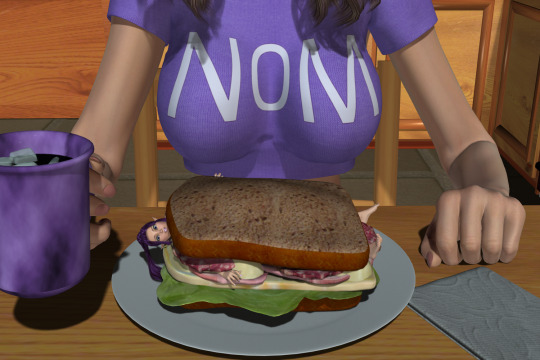
(okay so one of my followers, Lord-Verminaard, decided to make this pic for me as a surprise early birthday gift. I did not ask for this but I am grateful for receiving this all the same, this looks amazing! it’s a pic of Jora Bora’s OC Jorako about to dine on a delicious Celestia sandwich for her lunch. Thank you again for this early birthday gift Lord-Verminaard.)
#jora-bora#jorako#elven princess celestia#lord-verminaard#sandwich vore#giantess#implied vore#food prep
54 notes
·
View notes
Text
Dragonlance’s Lost Chronicles I: Dragons of the Dwarven Depths - A rambling review

Cover art by Matt Stawicki depicting Tanis Half-Elven, Flint Fireforge and Tasslehoff Burrfoot, three of the main characters.
By now I should be rereading the second trilogy of the Dragonlance Tales, but I couldn’t resist and started with this trilogy of The Lost Chronicles which, to my eternal shame as Dragonlance fan, I didn’t even know it existed until a few months ago during confinement, when I decided to re-explore this beloved franchise of my teen years. The Lost Chronicles is a relatively recent trilogy - year 2006 - if we compare it with the first original trilogy, Dragonlance Chronicles (1984) that complete each other. Those who have read the Chronicles will remember that after finishing the first volume - Dragons of Autumn Twilight - in the second, Dragons of Winter Night, the authors made a temporary leap omitting part of the story - due to lack of time and creativity, they admitted at the time - in which the main characters’ group was recovering a sacred relic from the Dwarven nation of Thorbardin, The Hammer of Kharas, in exchange for providing protection and accommodation to refugees driven from Solace and enslaved by the Dragon Highord Verminaard. Well, precisely, this what the first volume of The Lost Chronicles is about, written no less than 20 years later, to complete this and other gaps in the original plot.
I have to say that on one hand I was excited to find this trilogy written to complete the original, and on the other hand, I was skeptical about it. Because writing decades later to complete something you had already done usually results in a grievance compared to the original work; it seems unlikely that something better will be done so long later; and unless you go with the lead feet, reread your original work VERY WELL and have a good publisher, it’s very likely to fall into contradictions and inconsistencies in the plot.
Well, nothing of that! This book is great! Not only have the authors recovered the original spirit of the Chronicles, but also - at the risk of being burned as heretic at the bonfire of fandom - they have improved it, and how! On the other hand it is logical, because writers are supposed to improve with time if they care for what they do, and let's not forget that Weis and Hickman are also the authors of that wonderful series called The Death Gate Cycle, which it is totally on another level. All that experience of years has been invested now and it shows.
How does it show? The pace of the plot, for example. The Chronicles, specially the first volume, had a very stressful rhythm - it was like climbing a roller coaster without harness - while Dragons of the Dwarven Depths has a sensible and constant pace, dosing the action and the dialogues in a balanced, fluid and consistent way. Secondly: it’s much better written than the original trilogy, both in terms of prose and setting. They take more time to describe the environments and the lore without becoming tedious, boring, or too hasty as sometimes happened in the original trilogy. Of course, the poems of Michael Williams are still horrible - or perhaps it is the translation that is horrible, I will give him the benefit of the doubt -; that issue seems to be doomed.
And finally I stop at what has always been, for me, the best of Dragonlance and the reason why I love it: the characterization. It has always been wonderful, and in this volume it shows. The Companions, very different in their origins, abilities and personality, have always fascinated me because they seem absolutely human and relatable, believable although many of them are not "humans" per se or have supernatural abilities, of course. They are supposed to be childhood friends and allies of their own free will in a world at war, but they actually malfunction as some kind of dysfunctional family, if I may allow redundancy. The mean-spirited and grumpy dwarf messes with everyone and scolds them all like a curmudgeonly grandfather, the others handle him making him believe that his decisions matter and his intervention is essential to them, the knight won’t stop annoying everyone with his ideals of honor and justice, lecturing them on what is right and good and cooperating rather little when it comes to making morally questionable decisions, the mage messes with everyone and everyone messes with the mage, who reacts like a furious snake because he’s aware that without him they would not make it to the corner alive, and in the absence of a real culprit, his fangs always end up stuck in his poor twin - an actual cinnamon roll, an example of the most tragic Stockholm syndrome -; the barbarians distrust everyone but they have no choice but to get along with them, the kender is, if possible, the most chaotic element of the group, whose burden and responsibility are passing each other as if they could really control him somehow; all of them led by a half-elf with remorse of conscience because he’s a disbelieving atheist who cannot even make up his own mind about if he feels elf, feels human, feels everything or feels nothing, and is not able to choose if he is in love with the elf girl or of the human girl, having enough work with babysitting this sociopathic group. Anyway. A delight for the senses.
Already experts in handling such a bunch of misfits, Weis and Hickman make you laugh hard at the interactions between them. In the Chronicles it wasn’t yet quite funny - especially if you hadn’t gotten used to Raistlin's mood, whom you’ve to swallow in little doses like a bitter medicine - but here, you’ve a great time! The knight annoying the mage, the mage messing with the knight, the two messing with the dwarf, the dwarf messing with everyone, the kender in the middle messing around... it seems incredible that these people saved the world, right? Well, they did! And even though they can’t totally get along, without a single one of them it would not have been possible. There, the greatness of the story.
I don't want to wind up much more. In this volume, the authors take the opportunity to correct other failures their original narrative had, such as devoting more attention to Riverwind, who plays a fantastic role as leader of the refugees - at the cost of casting a shadow over Goldmoon and therefore obtaining the inverse result of the original trilogy - and also, to pay a little more attention to poor Tika - the most human and perhaps most relatable of them all, although unfortunately she’s forgotten, like Goldmoon, halfway through the book - and above all, pay much more attention to Flint Fireforge, the dwarf, who’s really the main character of the book, and who finds himself faced with a moral dilemma: recover the sacred relic of the dwarves, the Hammer of Kharas, and hide it from his own people to take it to the Knights of Solamnia and therefore be used as an artifact to solve the war and give the world in danger of destruction a chance; or willingly return it to the dwarf nation and risk losing it to the cause.
5 stars. Great. Fantastic. It’s not boring for a single moment, there is no tedious, long or unnecessary part, the characters are genuinely themselves, the plot is better written and the style much improved. In short: it seems that time has not passed at all, or rather, it has passed, but for good. Highly recommended for Dragonlance fans and especially for those who are already familiar with the Chronicles. You will not regret it.
Geez, I need to shorten these reviews.
4 notes
·
View notes
Photo

https://davventura.altervista.org/dof-laurana/ #Laurana è stata rapita e viene tenuta prigioniera qui insieme alle altre donne. La troviamo sola per ovvie esigenze di programmazione e per il fatto che la salviamo “due volte”: tutti i draconici sconfitti prima era un manipolo che la stava scortando da #Verminaard per certe faccende. Trovare Laurana è essenziale quanto recuperare la spada #Ammazzadraghi. https://www.instagram.com/p/CmdulnVIgxl/?igshid=NGJjMDIxMWI=
0 notes
Text
345. Tracy Hickman, Michael Dobson - DL4: Dragons of Desolation (1984)
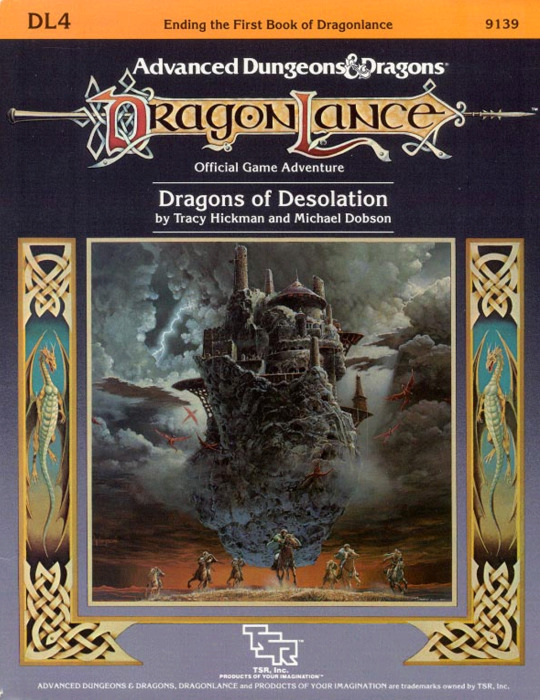
The final act of the first volume of the Dragonlance Saga (but far from the end of the adventure) sees the party crossing the Dwarven hold of Thorbardin and getting permission to take the 800 refugees from Pax Tharkas across to safety. The adventure also culminates with the battle against Verminaard and the wedding of Goldmoon to Riverwind.

So by the end of this module you finally achieve a resting point in the story and campaign, with the stage set for further adventures. As is typical of the Dragonlance modules this plays more like a kind of interactive fiction than as any kind of sandbox module, however the story is compelling enough to more than justify playing through it.

The story by this point also deviates enough from the published novels to make it worthwhile playing even if you know that story back to front. The whole Skullcap from DL3 and Thorbardin sections in this module are exclusive to the modules (although they would be later novelized as short stories in future years) and therefore make it unexpected parts of the adventure even with a party familiar with the Dragonlance Chronicles.
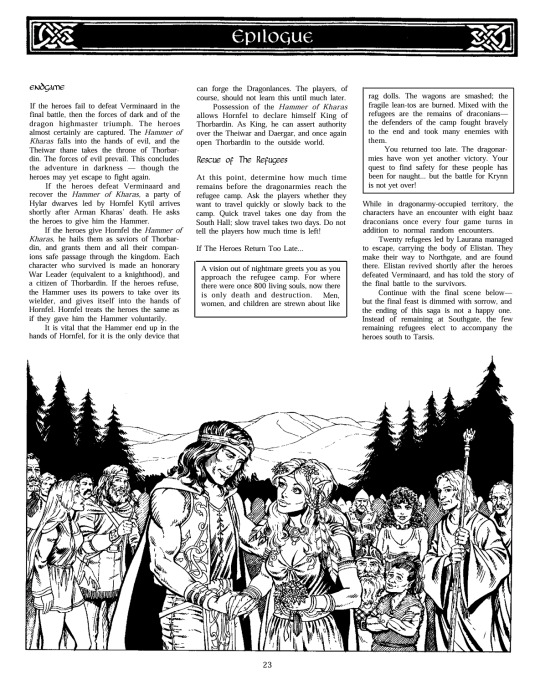
#adnd#dnd#ttrpg#ad&d#d&d#dnd art#dungeons and dragons#dungeons & dragons#Dragonlance#tracy hickman#Michael Dobson
7 notes
·
View notes
Text
verminaard's read of tanis being "a half-elf trying to pass himself off as human"

#this is just the big half-elf mood reaction image#when will yall leave tanis ALONE#mawd reads dragonlance
1 note
·
View note
Text
Dragonlance: la nascita di una grandissima saga fantasy
Correva il 1984 quando in America fu pubblicato il primo volume dedicato alla storia di Krynn: “I Draghi del Crepuscolo d’Autunno” (Dragons of Autumn Twilight), realizzato da Margaret Weiss e Tracy Hickman. Una prima lettura potrebbe classificare quest’opera come un banalissimo fantasy; in realtà in esso confluiscono i tratti più salienti della saga de “Il Signore degli Anelli” e del più famoso gioco di ruolo del tempo: Dungeons and Dragons. Il noto GDR (abb. di gioco di ruolo) nacque nel 1974, ad opera di Gary Gygax e Dave Arnerson, e pubblicato dalla casa editrice Tactical Studies Rules (TSR): la stessa che pubblicò l’opus magnum di Margaret e Tracy. In Italia la saga venne pubblicata dalla casa editrice Armenia.
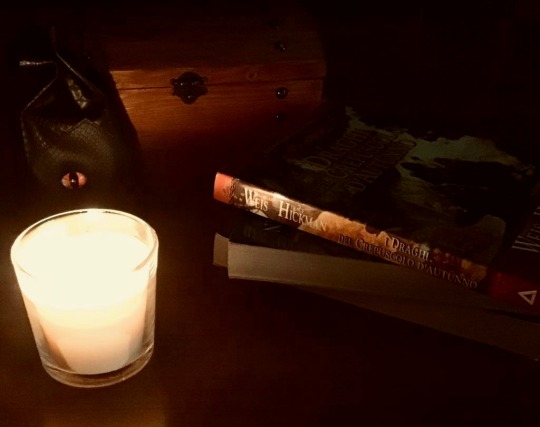
I “Draghi del Crepuscolo d’Autunno” sono soltanto il primo volume di una trilogia – di cui vi parlerò in seguito – appartenente al ciclo de “Le cronache di Dragonlance”. Gli eroi del romanzo si ritrovano cinque anni dopo essersi separati alla ricerca degli Dei antichi; quest’ultimi cinque secoli prima della narrazione dell’epoca delle Cronache abbandonarono, almeno apparentemente, le popolazioni al loro destino e scagliando su Krynn una montagna di fuoco. Dopo essersi ritrovati nella locanda dell’Ultima Dimora nella città di Solance, il leader Tanis Mezzelfo, il nobile cavaliere Sturm Brightblade, l’intrepido nano Flint Fireforge, il ladro kender – halfing per gli amanti di Dungeons and Dragons – Tasslehoff Burfoot, i gemelli Raistlin e Caramon Majere e i due barbari Goldmoon e Riverwind saranno costretti a fuggire nel Bosco di Draken. Dopo varie vicissitudini scoprono che in realtà gli Dei non hanno mai abbandonato le popolazioni ma che queste in realtà hanno abbandonato loro, e che i Draghi sono stati rievocati dalla terribile Regina delle Tenebre con l’obiettivo di sostituirsi agli Dei. Scoperto ciò i nostri eroi tenteranno di impossessarsi del potentissimo globo dei draghi, un manufatto in grado di controllare le potentissime creature, ma scoprono trovarsi nelle mani di Verminaard, un chierico Signore dei Draghi, comandante dell’esercito della Regina delle Tenebre. Dopo aver creato una rivolta nelle miniere di Pax Tharkas, grazie all’aiuto degli elfi di Qualinesti riescono a raggiungere e a sconfiggere il potentissimo Verminaard, facendolo precipitare dalla torre principale.
Sarà finita qui?
La risposta è scontata, ma dovremo aspettare il secondo volume “I Draghi della Notte di Inverno” per scoprirlo.
Nedo
#fantasy#libri#librifantasy#armenia#wizard of the coast#margaret weis#tracy hickman#dragonlance#le cronache#the chronicles#draghi#dragons#dungeons and dragons
0 notes
Photo

Verminaard and Ember intimidate Lord Toede while Tasslehoff Burrfoot looks on, in Jeff Easley’s cover art for AD&D Dragonlance module DL2: Dragons of Flame by Douglas Niles, TSR, 1984
#D&D#Jeff Easley#Dragonlance#dragon#Dungeons & Dragons#Dragons of Flame#red dragon#Tasslehoff Burrfoot#kender#Verminaard#Lord Toede#Ember#Douglas Niles#dnd#Dungeons and Dragons#TSR
162 notes
·
View notes
Photo
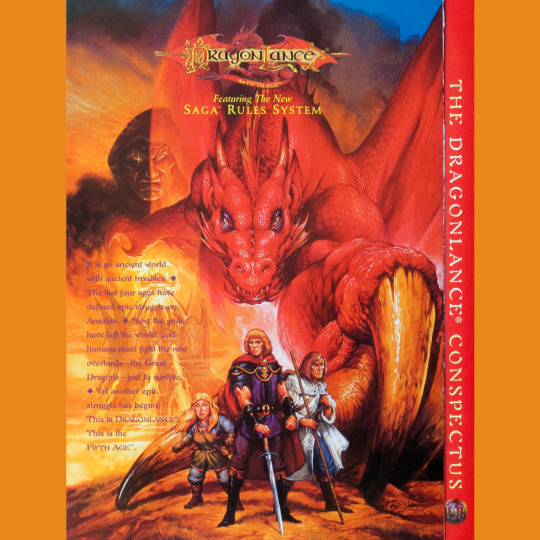
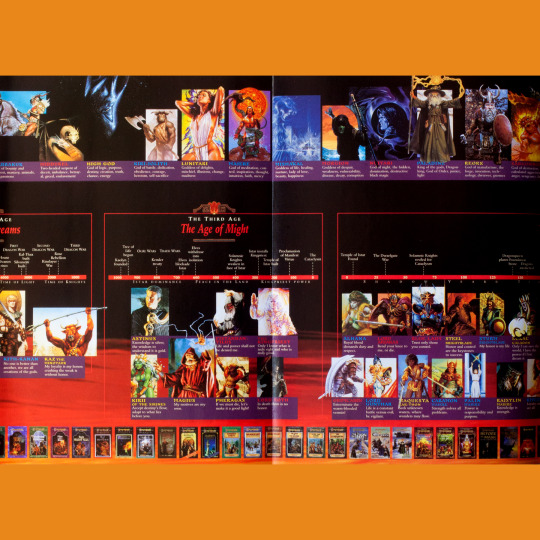
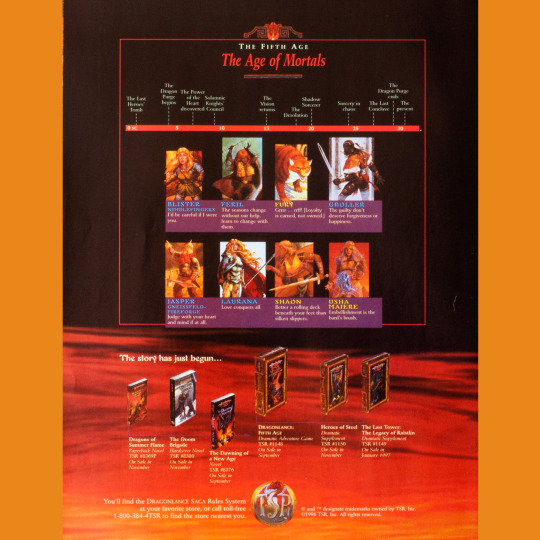
This conspectus was provided by my friends @nobleknightgames.
Poor Dragonlance doesn’t even get a full fold-out poster for its conspectus (1996). It is just a four panel fold-out brochure. This is tied to the Saga System relaunch of the line that, admittedly, I know very little about.
It mostly consists of a fairly inscrutable timeline punctuated by dozens of character portraits accompanied by a one-line motto. Raistlin’s is “Knowledge is strength.” Verminaard’s is “Glory in destruction.” Grimcairn’s, whoever he is, is “Exterminate the warm-blooded vermin!” At the bottom are billions of Dragonlance novel covers.
The section dedicated to the Fifth Age is rather anemic considering it is the focus of the new game system. One of the featured characters is a paunchy fox. Laurana is here too, and her inspirational quote is “Love conquers all,” which seems like a funny thing to say in a world recently conquered by dragons.
26 notes
·
View notes